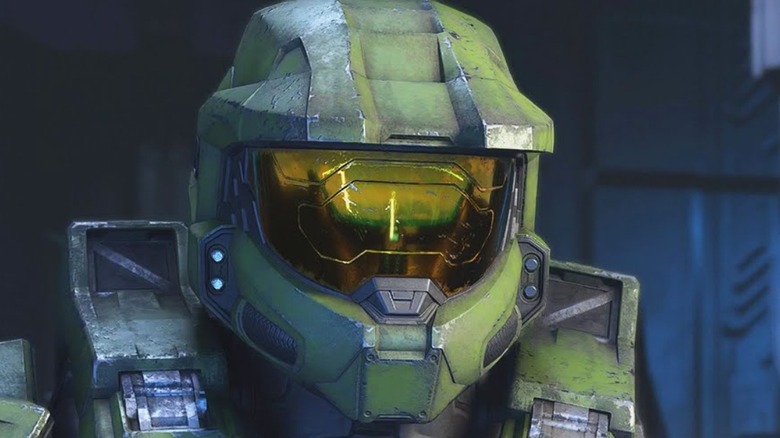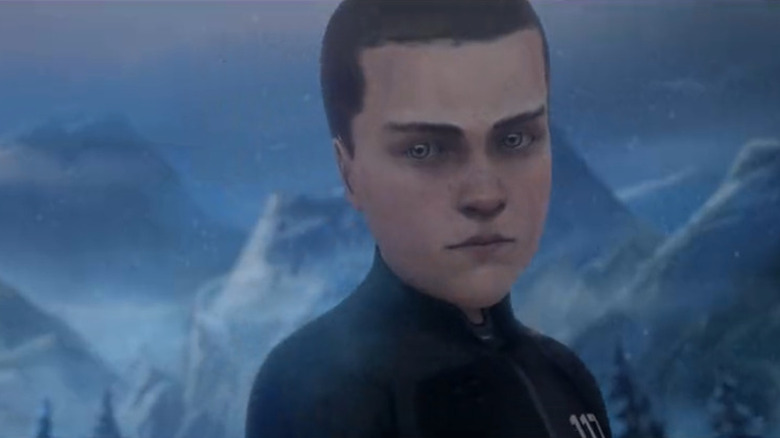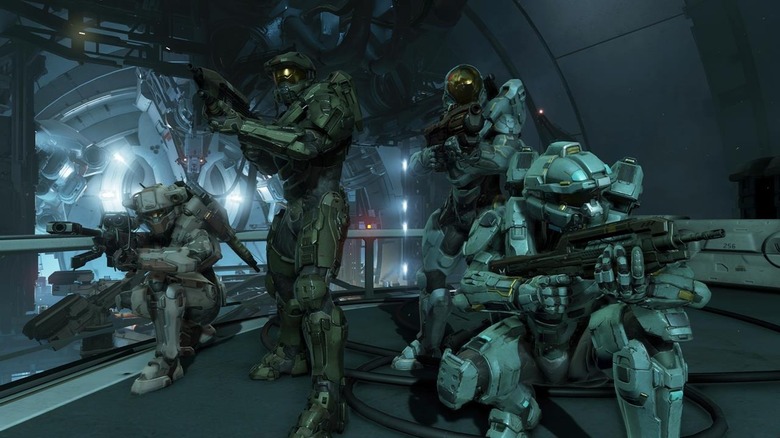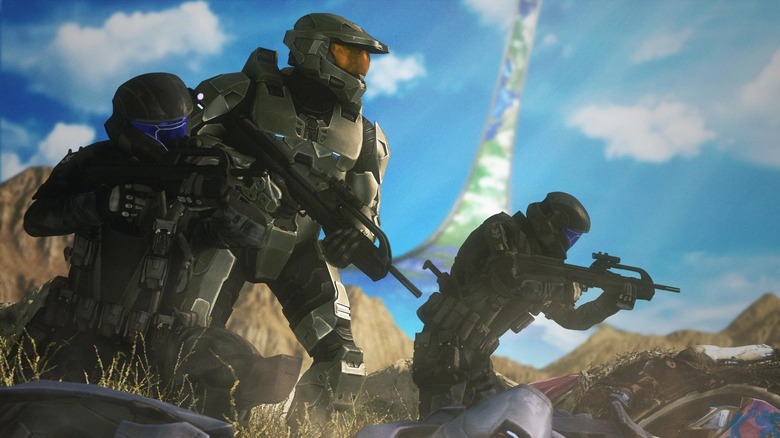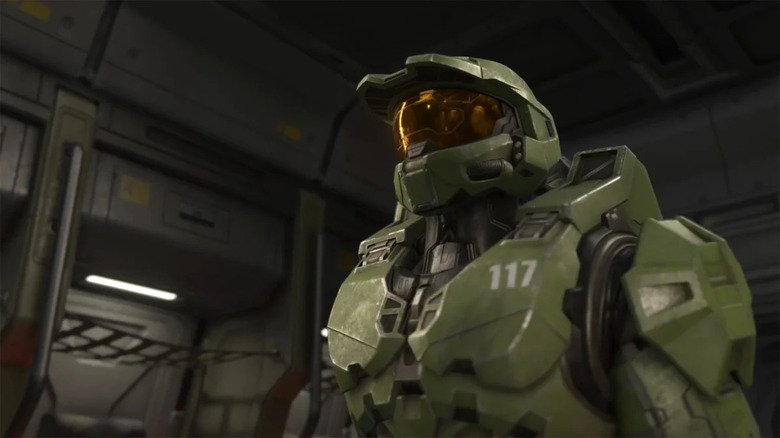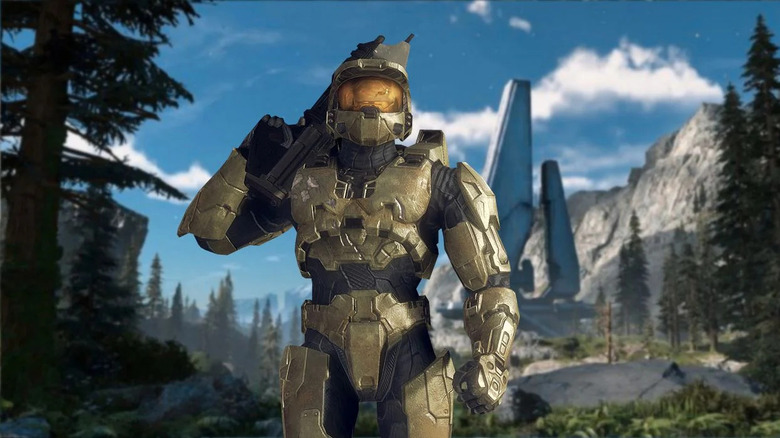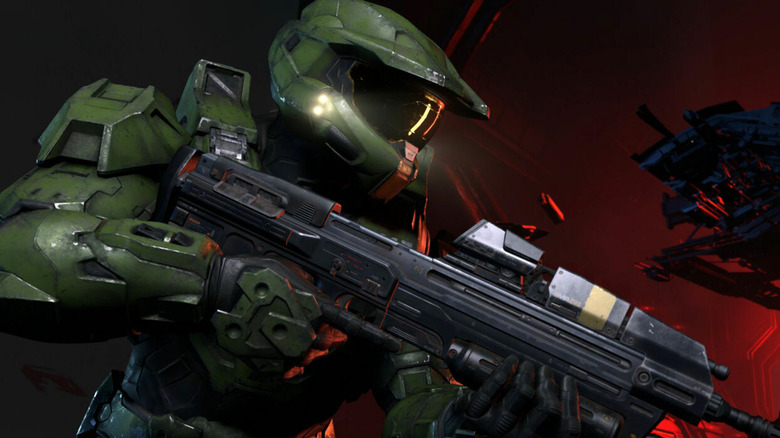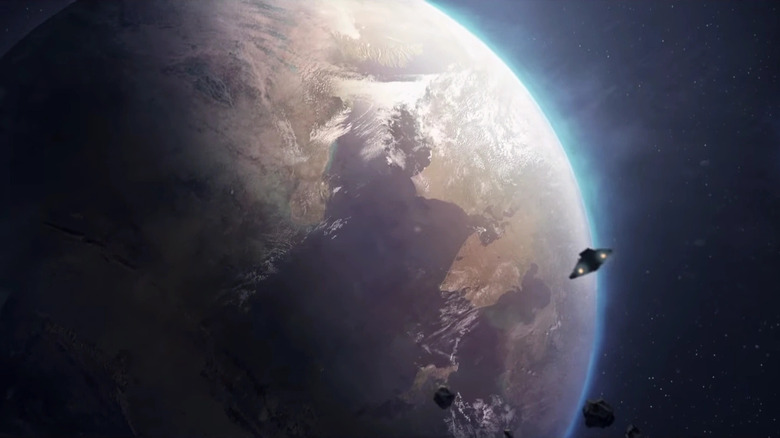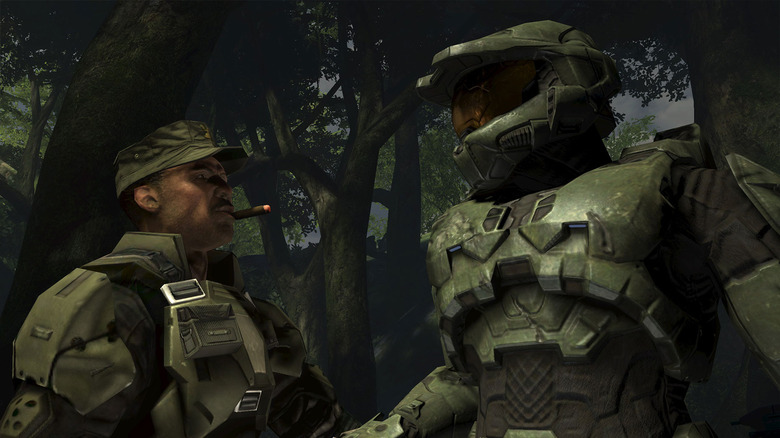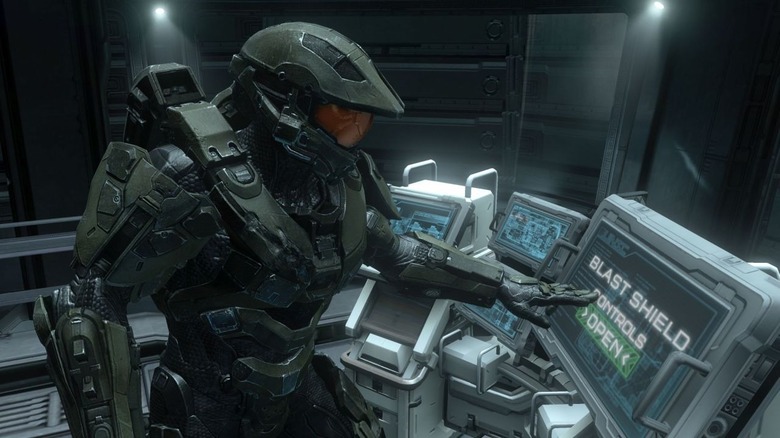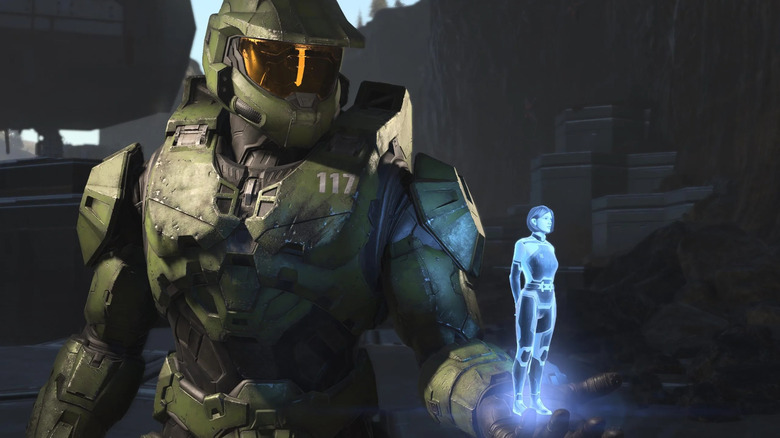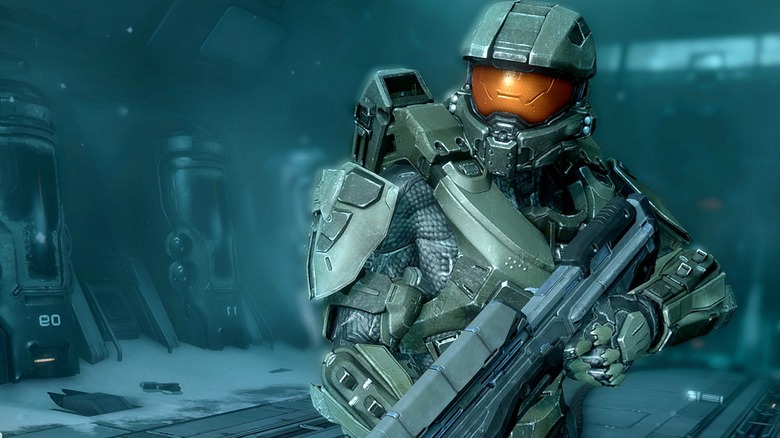What The Halo Games Don't Tell You About Master Chief
After more than twenty years spent with the super soldier, gamers feel like they know Master Chief pretty well. He's been the star of the "Halo" franchise since the very beginning, and though some of the games have introduced other main characters, Master Chief will always be synonymous with "Halo." But after half a dozen mainline games and countless slayed enemies, what do fans really know about him?
Master Chief is a man of few words. He's all about the action, and that doesn't leave much time for deep dives into his personal backstory. Master Chief has a history almost as confusing as the "Halo" timeline itself, but that tragic history has been fleshed out in books, comics, and films that the casual gamer has likely overlooked. With the story of "Halo Infinite" focusing on Master Chief more than "Halo 5" did, there's never been a better time to look back at one of the most important gaming characters of all time.
If you've never looked into the man behind the mask, get ready for a new understanding of the character fans have known and loved for more than twenty years. Here's everything the "Halo" games don't tell you about Master Chief, a.k.a. John-117.
He was conscripted as a six-year-old
Master Chief became humanity's savior, but his story began in a much darker place. The book "The Fall of Reach," which later became an animated film, explains that when John was just six years old, his size, strength, and intellect made him stand out to the UNSC. A researcher named Dr. Catherine Halsey became particularly interested in John when she noticed he was almost supernaturally lucky. Years later, John's AI companion Cortana saw that same quality and chose to work with John because of it.
Dr. Halsey chose the young John to join her SPARTAN-II super soldier program, and the UNSC transferred him to the planet Reach to begin his training immediately. John worked alongside dozens of other children, battling through grueling trials over the course of eight years in order to become near-perfect soldiers. By age 14, the children had completed their basic military training, and it was time for them to face the most challenging ordeal yet.
John and the other children underwent a genetic modification procedure designed to enhance their strength and reflexes, reinforce their bone density, and give them the ability to see in almost complete darkness. Unfortunately, not everyone survived the procedure unscatched. Of the 75 children given the genetic modifications, only 33 were alive and able to function as Spartan soldiers by the end of the process. The trauma experienced by young Spartans was the subject of the short film "Homecoming," featured in the "Halo Legends" anthology.
His family has no idea what happened to him
The UNSC did not ask John's parents for permission to train him as a soldier. In fact, the UNSC never even allowed them to know what happened to their son. John, like all the other Spartans, was kidnapped from his home. To keep the parents calm, the UNSC replaced the children with "flash clones." The clones were imperfect – with many struggling to have full motor function – and their bodies decayed over the course of several months until they died. John's parents, like the parents of all the SPARTAN-II candidates, likely believed their son had suddenly developed a fatal injury or illness.
Fans have debated whether or not the Spartans were aware of what had been done to them and their families. A handful of Spartans would get the chance to even see their own clones, but it's likely that most of the children were kept entirely in the dark.
Master Chief remembers bits and pieces of his life before becoming a soldier, and he even dreams about his mother while in cryosleep in the novel "Halo: The Flood." Unlike the other Spartans, John knows quite a bit about what the UNSC did to create their soldiers, and he would eventually find a way to deal with that knowledge.
He's killed friendly soldiers
The genetic augmentations that John and the other Spartan soldiers received came with a long adjustment period. The children all had difficulty fully controlling their bodies after the procedure, and none of them realized how strong they really were. While John was training with his new strength, he was attacked by three rowdy ODSTs in the gym. John fought back hard and accidentally killed his fellow trainees who were attacking him.
John had no idea that the entire time he was fighting the ODSTs, he was being observed by Dr. Halsey and Chief Mendez. They also had no real idea how strong their newly augmented Spartans had become, and so the fight proved a perfect opportunity to test that strength. Chief Mendez interrupted the fight at the very end, but he was too late to save the ODSTs.
Exactly how strong John is, especially compared to the other Spartans, is still a subject of debate among fans. Among the other SPARTAN-IIs, John likely wasn't the absolute strongest, but he could hold his own against any combatant. John is just as strong, if not stronger, than any Spartan who came after him, but he also seems to usually have the elusive advantage of being lucky.
He wasn't always the top choice to lead the Spartans
Seeing Master Chief effortlessly lead Marines into battle throughout the "Halo" games, it's easy to think that he was always the obvious choice for a leader. Earlier in his life, though, John didn't exactly stand out as someone who could command the loyalty of others. Before joining the UNSC, John was something of a schoolyard bully who often got into trouble for being too "rough" with the other kids during games.
John's prospects didn't immediately improve when he began his military training. The young soldier tended to be too self-centered and focused on his own success over that of his team. During an early training mission, John was punished when he personally came in first place by abandoning his team and letting them come in behind him.
John's instructors had different takes on his leadership abilities. The "Halo: Reach" limited edition included a copy of Dr. Halsey's journal that offered some insights into how she and Chief Mendez viewed the young trainee. Chief Mendez believed John was too ambitious and selfish to make a good leader. He had his eyes on another Spartan named Kurt as a potential team leader. Dr. Halsey, on the other hand, refused to play favorites. Even so, she never doubted John and his abilities for a second.
He earned his place by breaking orders
John's first true moment of leadership came when he decided to disobey — or at least creatively interpret — orders for the benefit of his team. He and the other Spartans were given a training mission during which their task was to navigate through a freezing cold environment and solve a puzzle to find an extraction point. The last trainee to get to the proper location would be forced to walk themselves back to base.
Once the Spartans had all been deployed, John gathered them together so they could collectively solve the puzzle and find the extraction point. While making their way through the snow-covered woods, the young Spartans stumbled onto what appeared to be a group of Insurrectionists with a stolen Pelican dropship. The Spartans overpowered the group (who were really out-of-uniform UNSC soldiers), took command of the Pelican, and flew back to base as a unit.
After the mission, John was brought before Chief Mendez and Dr. Halsey to explain what had happened on the mission. He explained that because the Spartans had all arrived at the Pelican at the same time, no one had been last, so no one needed to walk back. Impressed with John's display of leadership, Chief Mendez and Dr. Halsey decided not only to forgive John's action, but also give a promotion, making him the official leader of the Spartans.
He wasn't always fighting aliens
Anyone who's just played the "Halo" games probably imagines the Spartans were created to protect humanity from the Covenant, but that couldn't be further from the truth. At the beginning of the novel "The Fall of Reach," Dr. Halsey is hard at work creating the perfect soldier. She and the UNSC need all the help they can get in the bitter civil war tearing the galaxy apart. Organized Insurrectionists are rebelling against the government across its many worlds, and the UNSC can barely manage to keep up with their attacks, much less turn the tide against them. Dr. Halsey believes her Spartans can finally return peace to the galaxy.
Unfortunately for Dr. Halsey, and every other human alive, peace was still a long way off — but her Spartans would absolutely be necessary to achieve it. The book "Contact Harvest" explains how humanity first encountered the Covenant in 2525 and began a whole new war. Spartans were the only soldiers who could stand toe-to-toe with the alien races that populated the Covenant. Without them, humanity would be destroyed. But even with the help of super soldiers, the Covenant war would drag on for decades and take countless lives. While fighting the Covenant, humanity put its civil war on hold, but the Insurrectionists began to rise once more when the war settled.
His homeworld was an Insurrectionist base
John barely remembers his parents, and his earliest memories of his home planet are all but gone at this point. But he in fact grew up on Eridanus II, a planet that served as a center of Insurrectionist power during the civil war. When John was a young boy, demonstrations, violent attacks, and full scale rebellions against the UNSC were an everyday occurrence on his planet. None of that was exactly apparent to a six-year-old, but John would get the chance to experience it all firsthand almost a decade later.
As one of their first missions after receiving their genetic augmentations, the Spartans were sent right into the heart of the Eridanus system. The UNSC believed that Colonel Robert Watts, one of the Insurrectionists' primary leaders, had taken refuge on a ship hidden in an asteroid belt near Eridanus II. It was believed that Colonel Watts was planning an attack on medical satellites that would destabilize UNSC power in its outer colonies. Before that could happen, the Spartans were sent to capture Colonel Watts and hopefully put a permanent end to Insurrectionist activities in and around Eridanus. The Spartans succeeded in their mission, but just as Colonel Watts was being brought into custody, the Covenant were arriving on the planet Harvest.
He was present for the fall of Reach
For the first time in the game series, "Halo: Reach" had players take control of a Spartan who wasn't Master Chief. The game follows the Spartans of Noble Team as they valiantly, but vainly, try to defend the planet Reach from a Covenant invasion. Though many players might not be aware of it as they make their way through the game, Master Chief and his team of Spartans were also present for the fight on Reach.
The novel "The Fall of Reach" tells the tragic tale of Master Chief and his team as they try to save the planet. Master Chief splits the group, sending most down to the planets surface while he and two other Spartans board a Covenant prowler. While fighting their way through the alien ship, one of the Spartans takes a Needler to his jetpack thruster and is propelled out into the depths of space. Eventually, Master Chief and the remaining Spartan encounter Sergeant Johnson and some Marines. As the Spartans get the Marines to safety, Master Chief's other partner is killed by Covenant forces.
Master Chief, Sergeant Johnson, and a handful of other Marines are finally able to make their way aboard The Pillar of Autumn, but as the ship escapes, Master Chief is forced to watch helplessly as the Covenant scorch the planet, killing all the other Spartans in his team. When players enter the picture in the first "Halo: Combat Evolved," Master Chief, fresh off this loss, is the only Spartan left alive.
He's not really a lone wolf
Throughout the events of the "Halo" games, Master Chief is portrayed as a singular force within the UNSC. He often dives into battle headfirst and entirely on his own. He single-handedly destroys Covenant ships, takes out enemy battalions, and even neutralizes Halo rings. Because of that, many gamers view Master Chief as a lone wolf, but that couldn't be farther from the truth. In reality, the time Chief spends alone makes up a significant minority of his military career.
Master Chief first proved himself to be a team leader back in the 2510s during the early events of "The Fall of Reach." After many successful training missions, Master Chief was put in charge of the Spartans, and when humanity began its war with the Covenant, Chief's team became the most important line of defense. The miniseries "Halo: Collateral Damage" explores what happened when Master Chief led Blue Team through their earliest battles against the Covenant.
Master Chief continued to command Blue Team until the Covenant attack on Reach killed every member of the team. At that point, Master Chief began working alone by necessity. Some fans thought it was strange that Master Chief paired up with a new Blue Team in "Halo 5" instead of going after Cortana on his own, but in reality, Chief has a long history of being a team player, and the decision was really a return to form for the character.
He holds no grudge for what was done to him
Some of the expanded universe content in "Halo" occurs simultaneously with events in the games. The short story "Palace Hotel," which was included in the collection "Halo: Evolutions," expands on Master Chief's time in New Mombasa in the second game of the series. It also offers a heart-wrenching look at the Chief's loyalty to the UNSC.
In the story, Master Chief is attempting to make his way across the city after being shot down by a Covenant Scarab. He encounters a group of Marines taking cover beneath an underpass and decides to help them fight their way to safety. Together they battle through the infested streets of New Mombasa, eventually arriving at the Palace Hotel, which is being used as a military base of operations.
At the Palace Hotel, Master Chief meets the commanding officer, a lieutenant named Parisa. He's caught off guard, realizing that Parisa was once his friend back when he lived on Eridanus II as a child. Parisa, of course, doesn't recognize John, as she believes that her friend tragically died decades ago. Master Chief at first wants to tell Parisa who he is, but he realizes that people would be horrified to realize that the UNSC had once kidnapped children and transformed them into super soldiers. Master Chief still believes in the UNSC and its mission, knowing that it is the best hope humanity has against the Covenant. He keeps his identity to himself, and helps Parisa get all the Marines to safety.
He's no spring chicken
It's clear from the beginning of "Halo: Combat Evolved" that Master Chief's story began well before the game takes place, but many players likely don't realize just how long Chief has been working as a soldier. Humans first made contact with the Covenant in 2525, and according to events described in the novel "Contact Harvest," it took hardly any time at all for war to break out between the species.
As mentioned previously, by the time the Covenant war began, Master Chief had already been fighting alongside his fellow Spartans in the war between the UNSC and the Insurrectionists. The Spartans shifted their efforts to fight against the Covenant, and Master Chief led Blue Team in battle against the aliens for decades leading up to the final events of "The Fall of Reach," which took place in 2552.
This means that, by the beginning of the first "Halo" game, Master Chief is at least 40 years old. "Halo Infinite" takes place in 2560, so the Chief is pushing 50. Of course, thanks to his genetic modifications and the amount of time he's spent in cryosleep between missions, it's highly likely that Master Chief's physical age is quite different from what his driver's license would say (if he had one). With any luck, Master Chief will still be in fighting shape and ready to defend humanity well into his seventies.

